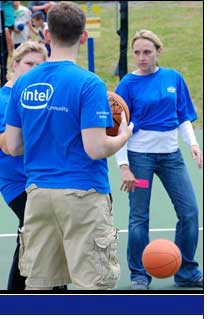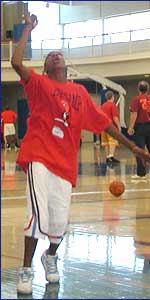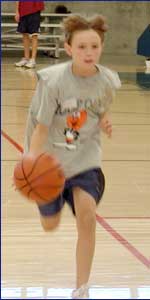
|
1 |
 |
Teaching is an integral part of coaching. A coach must be a teacher. This is true at all levels of
coaching. |
2 |
 |
Treat every child or adult who has special needs like you would treat anyone else. Teaching any sport
to an individual with a special need is not much different than teaching to any member of your community. Don't
try to make the athletes feel they are different or special. Most importantly, respect your
athletes as dignified individuals. |
3 |
 |
It may take more time to
teach skills and routines to an athlete who has special needs. In addition to knowledge of
coaching techniques and tactics, you will also need patience, understanding and insight
to work with your special athletes. |
4 |
 |
Break all skill work
into multiple progressions. You may see a basketball activity as having two basic steps. The
experienced coach realizes the activity might be better communicated to
special athletes by breaking the drill into four or five fundamental points. |
5 |
 |
Learn as much as possible
about each individual's background. Be alert to each individual athlete's particular
temperment, medications and any physical or mental special needs. |
6 |
 |
Keep instructions simple
and repeat explanations as often as possible. Demonstrate each aspect of the skill activity.
Explain "why" as well as "how." This helps the athlete understand "what" is expected. |
7 |
 |
Instructions will
have to be repeated often not only in a practice session, but from one session to the
next. Skills from a previous session may have been forgotten. Attention spans of
special athletes can be extremely short. |
8 |
 |
Let your athletes watch,
but quickly allow them the opportunity to try the skill for themselves. Athletes with
special needs learn by doing even more than traditional athletes. |
9 |
 |
Show your athletes that
sport is fun. Show your enthusiasm when coaching. Incorporate fun drills and
games into the practice sessions. |
10 |
 |
Encourage your
athletes by emphasizing what they have accomplished. However, continue to challenge them to
improve and do more. |
 |
L
A
Y
U
P
S |
 |
The layup is probably the
most fundamental of all basketball skills. It is, therefore, an important skill activity at
HoopCamp. Not only is the layup an essential basketball skill, layups are a great way for
athletes to warm up. Begin every practice session or game by having your athletes complete layups.
As most players are right handed, start on the right side. Begin the layup drill from behind the
three point line. Have the athletes dribble to the hoop while concentrating on not looking at
the ball and keeping their eyes on the target -- the basket.
For the right hand layup, the athlete takes off of the left foot. Both hands accompany the
ball to the shooting position. The athlete should loft the ball softly toward the hoop. It
is important to have the athletes use the backboard when shooting layups -- unless they
can dunk. After completing a few cycles of right hand layups, switch to the left side. Many
athletes will have trouble from this side. Encourage your athletes to
dribble with their left hands. While they should work toward shooting with the left hand,
allow smaller and younger players to shoot with their "strong" hand. |
 |
D
R
I
B
B
L
I
N
G |
 |
Experienced coaches know
there is generally too much dribbling in basketball. You will find this to be
true at HoopCamp. Encourage players to dribble only as necessary, and when they dribble,
players should do so with the purpose of advancing the ball to the basket.
Begin by instructing athletes how to dribble with their right hand. As seen in the picture to
the left, the athlete should assume a relaxed body position. Legs are bent slightly, feet
are shoulder width apart and the butt is down. When dribbling with the right hand,
the left foot should be slightly advanced. Most importantly, the head is up. Focus on this!
Teach the athletes to "pound" the ball down when they dribble. The faster the ball goes down, the
more quickly it comes back in their hand. They should use their off arm, in this case, their left arm,
to shield off the defender. Do not allow them to push off, but teach them how to protect themselves
and the ball from the defensive player. |
 |
P
A
S
S
I
N
G |
 |
Coaches, and players, like
players who can pass. You will find that Special Olympians have difficulty with
this skill activity -- particularly in game sessions. Focus on this at all times. At Hoop
Camp, we encourage passing to instill teamwork.
Begin your passing drills by having the passer assume a relaxed, but poised, position as
shown at left. Legs are bent, butt is down, one foot should be slighly in front of
the other. As with dribbling, the head and eyes are up as they look for the target.
We will work on four basic passes at HoopCamp: the two-handed chest pass, the two-handed
bounce pass, the one-handed push pass and the two-handed above-the-head pass. |
 |
S
H
O
O
T
I
N
G |
 |
This is everyone's favorite activity at HoopCamp. In general, good shooters do the following things
well. They begin in a relaxed, but poised, body position (as shown at left). They keep their
head up and eyes focused on the basket. They use their legs to give them power. Their arms
stay relaxed to allow "touch" on the ball.
In your shooting drills, begin by working on the athlete's body position. For right-handed
shooters, the right foot should be slightly advanced. As the athlete brings the ball up, they
should keep both hands on the ball. Shooters need to get their shooting elbow up -- the elbow
should point toward the basket. They also need to arc the ball toward the basket. Have your
athletes imagine they are shooting out of a telephone booth. Work on four types of shooting:
spot shooting, free throws, three-pointers and shooting off the dribble. |
 |
D
E
F
E
N
S
E |
 |
At HoopCamp, all our athletes play great defense. The secret is hard work, patience and persistence.
Playing defense begins by assuming a relaxed, but poised, body position.
The feet are slightly wider than shoulder width apart. Legs are bent comfortably, the butt
is down (like sitting in a chair) and the head is up.
In the defensive stance, one foot should be slightly advanced. This
is the strong side. The defensive player wants to push the offensive player
opposite the foot that is slighly advanced. Hand activity and positioning are important parts
of defense. One hand should be up to block the offensive player's vision as well as passes. The other
should be down to swipe at the ball. In drills, have players slide side-to-side
as well as back and fourth. Make sure they stay in their defensive position keeping
their feet apart (not crossing), butt down, hands active and head up.
One component of defense is rebounding. Begin your rebounding drill by having the players
assume their defensive stance, backs to the basket. Shoot the ball, and have the
players turn, track the flight of the shot, and hustle to win the rebound. For advanced players, have
them block out the offensive player while turning to find the ball.
© InfoImagination 1998 |
|
|


